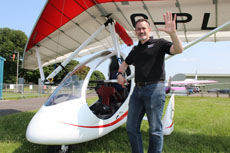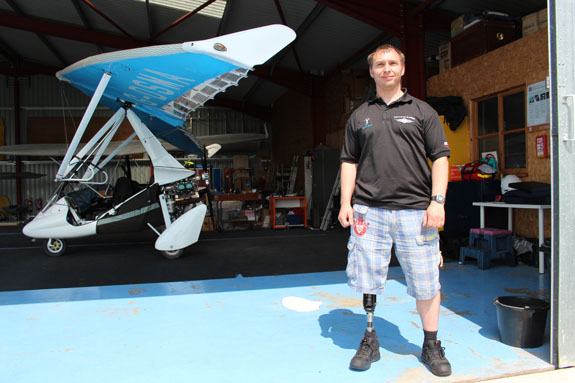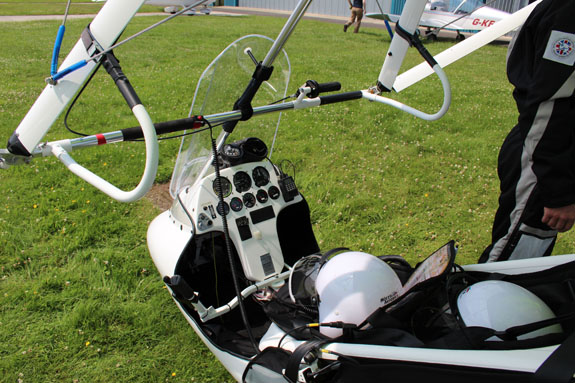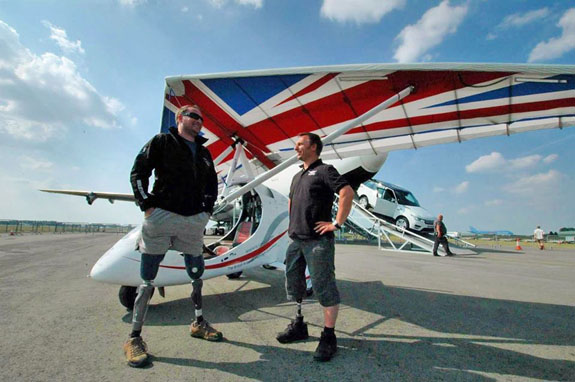
John Laity – wants 5 PulsRs for the expedition
As you’ll remember from episode 63 the Fly2Pole team are endeavouring to get several disabled military personnel to the South Pole in microlight aircraft. So, when the Flying for Freedom team held a sponsor’s open day a few weeks ago I popped down to Kemble for a bit of a catch-up.
The team’s Quik GTR and the prototype PulsR were there and so I was able to see what they were planning in the way of modifications and several of the pilots were there too. The long term aim of Flying for Freedom is to get injured soldiers to learn to fly microlights and maybe then go on to become instructors.

Alan Robinson
I first spoke to Alan Robinson who is currently a mechanic with the RAF at Waddington. He lost a leg a few years back in a motorcycle accident and has since learned to fly microlights. His training began at Old Sarum on Shadows moving on to Thrusters at Fly365 at Wickenby and then flex-wings at Kemble.
He was already well on his way to his licence when he saw the opportunity to fly to the South Pole with the Flying for Freedom expedition.
Alan is quite determined to get to the pole and doesn’t think that missing his lower leg will cause to many problems. Most of his microlight training has in fact taken place on unmodified aircraft. Pace Prosthetics are looking at developing a leg that will cope with the extreme cold but Alan says that he might just end up take a simple peg-leg. Cold weather testing early in 2014 will confirm what type of leg will work effectively on the Fly2Pole expedition.
After the trip he is considering becoming a microlight AFI and passing on his skills to fellow military types.
I also spoke to Mike Oakley, the CFI for the Flying for Freedom project at Kemble.
www.kembleflyingclub.com
He has been instrumental in training most of the pilots that are aiming to fly microlights to the pole.
It was interesting to hear from Mike how each of the Fly2Pole pilots’ disabilities has affected their training. He says that the soldiers have proved to be good students, progressing more quickly than your average pilot. He puts this down to the fact that they have a firm goal in mind or, being military personnel, they are typically quite determined personalities. Some disabilities, particularly the loss of an arm, do make flying a flexwing more of a challenge but Mike is impressed with the progress of those pilots that only have the full use of one arm.

The mods shown on the Quik
He does say that they won’t be making any allowances for disability. Each pilot must perform as any other potential aviator in progressing towards their licence.
Mike has flown in lots of different countries around the world and is going along to Antarctica too but he’s not too bothered about getting to the pole itself. He’s more motivated by helping the injured, Fly2Pole, service personnel achieve their goal of flying over the South Pole.
Lastly I spoke to project founder John Laity and I asked him how the expedition’s planning was coming together.
John says that the team are busy readying the PulsR for live, cold weather testing next January and they are working with EADS Innovation Works with the aim of replacing all of the small, fiddly clips and pins that hold the wing together. These could quite easily be dropped and lost in the snow when being handled with large, bulky, gloved hands. The pins will be 3D printed in titanium with large dished heads to make them easier to handle and less easy to drop in the extreme cold. The wing fabric will be cold weather tested in Qinetiq’s environmental chambers at Boscombe Down later this year.
Starting with the standard PulsR pod various mods will be added. The adaptations include a hand throttle on the control bar and a steering bar, complete with hand brake, to enable people without legs to steer and stop.

PulsR with new Union Flag wing
With the help of sponsors the guys now have an adapted Quik GTR training aircraft enabling all team members to fly the aircraft.
EADS will be creating some titanium mounting brackets for skis to replace the wheels on the trike and they’ll also be building some baggage pods to replace the wheel spats which won’t be needed with the skis fitted. The 3D printing facility also means that the team can trial all sorts of bodywork mods such as vents for fitting engine pre-heaters without the cost of creating moulds for forming the plastic parts ‘and having Richard Meredith-Hardy attack the aircraft with a saw’, according to John.
The Royal Princes have made some money available to the team so John says you could call it Royal patronage. They still need more cash and a confirmed fuel sponsor to make the expedition a definite prospect but John is fairly confident that they’ll be taking 5 PulsR aircraft to Antarctica.
The new style Union Flag wing is already in manufacture and they’ll hopefully be starting to order several PulsRs as sponsorship money comes in.
You can follow the project on the Flying for Freedom web site:
flyingforfreedom.org
